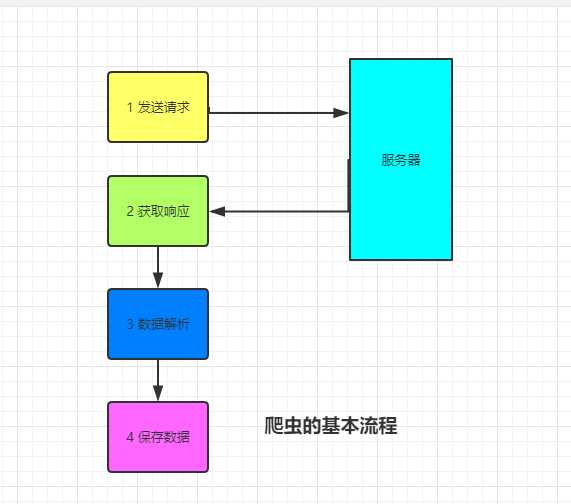标签:情况 ESS 爬虫 .post headers 排序 正则表达 str []
网络爬虫(又被称为网页蜘蛛,网络机器人,在FOAF社区中间,更经常的称为网页追逐者),是一种按照一定的规则,自动地抓取万维网信息的程序或者脚本。
在互联网的世界里最有价值的便是数据, 谁掌握了某个行业的行业内的第一手数据, 谁就是该行业的主宰. 掌握了爬虫技能, 你就成了所有互联网信息公司幕后的老板,
换言之,它们都在免费为你提供有价值的数据。
如果自己的门户网站中的指定页面中的数据不想让爬虫程序爬取到的话,那么则可以通过编写一个robots.txt的协议文件来约束爬虫程序的数据爬取。robots协议的编写
格式可以观察淘宝网的robots(访问www.taobao.com/robots.txt即可)。但是需要注意的是,该协议只是相当于口头的协议,并没有使用相关技术进行强制管制,所以
该协议是防君子不防小人。

Requests是用python语言基于urllib编写的, 采用的是Apache2 Licensed开源协议的HTTP库, Requests它会比urllib更加方便, 可以节约我们大量的工作. 一句话,
requests是python实现的最简单易用的HTTP库, 建议爬虫使用requests库. 默认安装好python之后, 是没有安装requests模块的, 需要单独通过pip安装.
import requests requests.get("http://httpbin.org/get") requests.post("http://httpbin.org/post") requests.put("http://httpbin.org/put") requests.delete("http://httpbin.org/delete") requests.head("http://httpbin.org/get") requests.options("http://httpbin.org/get")
1. 基本请求
import requests response=requests.get(‘https://www.jd.com/‘,) with open("jd.html","wb") as f: f.write(response.content)
2. 含参数请求
import requests response=requests.get(‘https://s.taobao.com/search?q=手机‘) response=requests.get(‘https://s.taobao.com/search‘,params={"q":"美女"}): f.write(res.content)
3. 含请求头请求
import requests headers = { "User-Agent": "Mozilla/5.0 (Windows NT 10.0; Win64; x64) AppleWebKit/537.36 (KHTML, like Gecko) Chrome/72.0.3626.119 Safari/537.36" } #反爬机制: UA反爬 res = requests.get("https://www.baidu.com/s",params={"wd":"刘亦菲"}, headers=headers) with open("jay.html","wb") as f: f.write(res.content)
4. 含cookies请求
import uuid import requests url = ‘http://httpbin.org/cookies‘ cookies = dict(sbid=str(uuid.uuid4())) res = requests.get(url, cookies=cookies) print(res.text)
1 data参数
requests.post()用法与requests.get()完全一致,特殊的是requests.post()多了一个data参数,用来存放请求体数据
import requests res = requests.post("http://httpbin.org/post",params={"a":"10"}, data={"name":"Alex"} ) # 没有指定请求头 #默认的请求头: application/x-www-form-urlencoded print(res.text)
2. 发送json数据
import requests # 发送json数据 res = requests.post(url="http://httpbin.org/post", json={"age":"38"}) # # 默认的请求头: application/json print(res.text) # 同时有data和json参数时 data参数优先
import requests # 1 创建session对象 使用方法和requests.get() .post 一致 session = requests.session() res1 = session.get("https://github.com/login") #后面的访问都会带着获取的session去访问 res2 = session.post("https://github.com/session")
1. 常见属性
import requests respone=requests.get(‘https://sh.lianjia.com/ershoufang/‘) # respone属性 print(respone.text) print(respone.content) print(respone.status_code) print(respone.headers) print(respone.cookies) print(respone.cookies.get_dict()) print(respone.cookies.items()) print(respone.url) print(respone.history) print(respone.encoding)
2. 编码问题
import requests res = requests.get("http://www.autohome.com/news") # res.encoding = "gbk" # with open("autohome.html","w") as f: # f.write(res.text) #汽车之家网站返回的页面内容为gb2312编码的,而requests的默认编码为ISO-8859-1,如果不设置成gbk则中文乱码 # 或者也可以以"wb" 模式写入文件 with open("autohome.html","wb") as f: f.write(res.content)
3. 下载二进制文件(音频,视频,图片)
import requests res = requests.get("https://video.pearvideo.com/mp4/adshort/20190222/cont-1520612-13609117_adpkg-ad_hd.mp4") with open("lsp.mp4","wb") as f: # f.write(res.content) # 比如下载视频时,如果视频100G,用response.content然后一下子写到文件中是不合理的 for line in res.iter_content(): f.write(line)
4. 解析json数据
import requests import json response=requests.get(‘http://httpbin.org/get‘) res1=json.loads(response.text) #太麻烦 res2=response.json() #直接获取json数据 print(res1==res2
5. Redirection and History
默认情况下, 除了head, requests会自动处理所有重定向. 可以使用响应对象的history方法来追踪重定向. Response.history是一个Response对象的列表,
为了完成请求而创建了这些对象. 这个对象列表按照从时间先后顺序进行排序.
import requests res = requests.get("http://www.jd.com") print(res.url) # https://www.jd.com/ print(res.status_code) # 200 print(res.history) # [<Response [302]>]
另外, 可以通过allow_redirects 参数禁用重定向处理
import requests res = requests.get("http://www.jd.com", allow_redirects=False) print(res.status_code) # 302 print(res.history) # []
一些网站会有相应的反爬虫措施,例如很多网站会检测某一段时间某个IP的访问次数,如果访问频率太快以至于看起来不像正常访客,它可能就会会禁止
这个IP的访问。所以我们需要设置一些代理服务器,每隔一段时间换一个代理,就算IP被禁止,依然可以换个IP继续爬取。
res=requests.get(‘http://httpbin.org/ip‘, proxies={‘http‘:‘112.17.121.88:8060‘}).json() print(res)
import requests,re # 1 请求获取token, 以便通过post请求校验 session = requests.session() res = session.get("https://github.com/login") token = re.findall(‘<input type="hidden" name="authenticity_token" value="(.*?)"‘,res.text)[0] print(token) # 2 构建post请求数据 data={ "commit":"Sign in", "Sign in": "?", "authenticity_token": token, "login": "aflychen", "password":"afly264028" } response = session.post("https://github.com/session",data=data) with open("github.html","wb") as f: f.write(response.content)
UA反爬: 在request请求头中有一个User-Agent的参数, 服务器通过判断请求是否携带此参数, 来判断访问端是人还是机器.
token反爬: 登录校验是判断请求的formdata中是否含有此数据来判断请求是否合法.
标签:情况 ESS 爬虫 .post headers 排序 正则表达 str []
原文地址:https://www.cnblogs.com/af1y/p/10451777.html